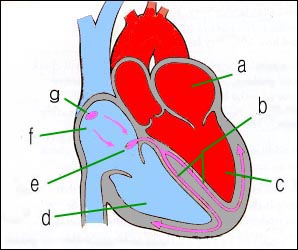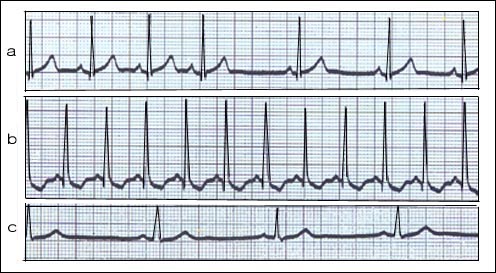동성 부정맥(호흡성 부정맥/생리적 부정맥), Sinus arrhythmia(Respiratory arrhythmia/Physiologic arrhythmia
- 심장이 불규칙적으로 박동할 때 생기는 맥박을 부정맥이라고 한다.
- 심장에 어떤 이상이 없고 아주 정상일 때도 심장이 불규칙하게 박동해서 부정맥이 정상적으로 생길 수 있다.
- 이처럼 정상적으로 생기는 부정맥을 동성 부정맥이라 한다.
- 심장이 비정상적으로 불규칙하게 박동될 때 생기는 부정맥을 이상 부정맥 또는 비정상 부정맥이라고 한다.
- 이상 부정맥에는
-
- 기외수축 부정맥,
- 발작성 빈박,
- 방실 차단성 부정맥 등으로 분리된다.
- 다음 각 부정맥 항 참조.
동성 부정맥(호흡성 부정맥/생리적 부정맥)
Sinus arrhythmia(Respiratory arrhythmia/Phyisologic arrhythmia)

그림 62. 심장 혈관과 심장자극 전도계
a-좌심방, b-심장자극 전도계의 왼쪽 다발 가지, c-좌심실, d-우심실, e-방실 결절, f-우심방, g-동방 결절
Copyright ⓒ 2011 John Sangwon Lee, MD, FAAP
- 정상 심장이 정상적으로 불규칙하게 박동할 때 생기는 부정맥을 동성 부정맥이라고 한다.
- 동성 부정맥은 정상 심장 박동의 일종이다. 그로 인해 건강상 아무런 지장이 생기지 않는다.
- 동성 부정맥에는 동성 빈맥과 동성 서맥이 있다.
- 심장 자극전도가 동방 결절에서 시작해서 방실계 결절로 정상적으로 전도되면서 생기는 정상적인 부정맥이다.
- 사춘기 아이들과 성인들의 동성 리즘 수(동성 맥박 수)가 1분 당 60~100이면 정상이고 1분 당 100 이상이면 동성 빈맥, 분당 60 이하이면 동성 서맥이라고 한다.
- 건강한 소아청소년들이나 성인들은 사소한 자극으로 숨을 다소 불규칙하게 쉬는 것이 정상이다. 그와 마찬가지로 심장도 정상적으로 다소 불규칙하게 박동할 수 있다.
- 나이가 어릴수록 숨을 정상적으로 더 불규칙하게 쉬고 심장도 정상적으로 불규칙하게 박동한다.
- 숨을 들이 쉴 때는 심장 박동이 정상적으로 더 느리고 숨을 내쉴 때는 정상적으로 심장 박동이 좀 더 빠르다.
- 이런 이유 때문에 건강한 아이들의 심장 박동이 호흡에 따라 정상적으로 조금 불규칙하게 박동할 때가 있다.
- 이와 같이 정상적으로 불규칙하게 뛰는 심장박동을 동성 부정맥, 호흡성 부정맥 또는 생리적 부정맥이라고 한다.
- 동성 부정맥은 고열이 나는 소아청소년들이나 미숙 신생아들에게서 더 자주 볼 수 있다.
- 동성 부정맥은 정상적인 맥박이기 때문에 치료가 필요 없다.

그림 63. 심장전도(심전도)
a-동성 부정맥, b-동성 빈맥, c-동성 서맥
Copyright ⓒ 2011 John Sangwon Lee, MD, FAAP
Sinus arrhythmias (respiratory arrhythmias/physiologic arrhythmias)
• A pulse that occurs when the heart beats irregularly is called arrhythmia. • Even when there is no abnormality in the heart and it is very normal, the heart may be beating irregularly and arrhythmia may occur normally.
• This normally occurring arrhythmia is called sinus arrhythmia.
• Arrhythmias that occur when the heart beats abnormally and irregularly are called abnormal arrhythmias or abnormal arrhythmias.
• For abnormal arrhythmias
• o Extrasystole arrhythmias,
o paroxysmal tachycardia,
o It is separated by atrioventricular arrhythmias.
• See each arrhythmia section below.
Sinus arrhythmias (respiratory arrhythmias/physiological arrhythmias)

Figure 62. Cardiovascular and cardiac impulse conduction system a – left atrium, b – left bundle branch of the cardiac impulse conduction system, c – left ventricle, d – right ventricle, e – atrioventricular node, f-right atrium, g – sinus node Copyright ⓒ 2011 John Sangwon Lee, MD, FAAP
• An arrhythmia that occurs when a normal heart beats normally and irregularly is called sinus arrhythmia.
• Sinus arrhythmias are a type of normal heartbeat. This does not cause any harm to health.
• Sinus arrhythmias include sinus tachycardia and sinus bradycardia.
• Normal arrhythmia caused by cardiac impulse conduction from the sinus node to the atrioventricular node normally.
• In adolescent children and adults, if the rate of sinus rhythm (sin-sex pulse rate) is 60 to 100 per minute, it is normal, if it is more than 100 per minute, it is sinus tachycardia, and if it is less than 60 per minute, it is called sinus bradycardia.
• It is normal for healthy children and adults to breathe somewhat irregularly with minor stimulation. Similarly, the heart may be beating normally rather irregularly.
• The younger you are, the more irregular you breathe normally and the more irregular your heart beats normally.
• When you breathe in, your heart beats normally slower and when you breathe out, your heart normally beats faster.
• For this reason, the heartbeats of healthy children are sometimes slightly irregular as they normally do with breathing.
• This normally irregular heartbeat is called sinus arrhythmia, respiratory arrhythmia, or physiological arrhythmia.
• Sinus arrhythmias are more common in children with high fever and premature newborns.
• Sinus arrhythmias do not require treatment because they have a normal pulse.

Figure 63. Electrocardiogram (ECG) a – sinus arrhythmia, b – sinus tachycardia, c – sinus bradycardia Copyright ⓒ 2011 John Sangwon Lee, MD, FAAP
출처 및 참조 문헌 Sources and references
- NelsonTextbook of Pediatrics 22ND Ed
- The Harriet Lane Handbook 22ND Ed
- Growth and development of the children
- Red Book 32nd Ed 2021-2024
- Neonatal Resuscitation, American Academy Pediatrics
- www.drleepediatrics.com 제1권 소아청소년 응급 의료
- www.drleepediatrics.com 제2권 소아청소년 예방
- www.drleepediatrics.com 제3권 소아청소년 성장 발육 육아
- www.drleepediatrics.com 제4권 모유,모유수유, 이유
- www.drleepediatrics.com 제5권 인공영양, 우유, 이유식, 비타민, 미네랄, 단백질, 탄수화물, 지방
- www.drleepediatrics.com 제6권 신생아 성장 발육 육아 질병
- www.drleepediatrics.com제7권 소아청소년 감염병
- www.drleepediatrics.com제8권 소아청소년 호흡기 질환
- www.drleepediatrics.com제9권 소아청소년 소화기 질환
- www.drleepediatrics.com제10권. 소아청소년 신장 비뇨 생식기 질환
- www.drleepediatrics.com제11권. 소아청소년 심장 혈관계 질환
- www.drleepediatrics.com제12권. 소아청소년 신경 정신 질환, 행동 수면 문제
- www.drleepediatrics.com제13권. 소아청소년 혈액, 림프, 종양 질환
- www.drleepediatrics.com제14권. 소아청소년 내분비, 유전, 염색체, 대사, 희귀병
- www.drleepediatrics.com제15권. 소아청소년 알레르기, 자가 면역질환
- www.drleepediatrics.com제16권. 소아청소년 정형외과 질환
- www.drleepediatrics.com제17권. 소아청소년 피부 질환
- www.drleepediatrics.com제18권. 소아청소년 이비인후(귀 코 인두 후두) 질환
- www.drleepediatrics.com제19권. 소아청소년 안과 (눈)질환
- www.drleepediatrics.com 제20권 소아청소년 이 (치아)질환
- www.drleepediatrics.com 제21권 소아청소년 가정 학교 간호
- www.drleepediatrics.com 제22권 아들 딸 이렇게 사랑해 키우세요
- www.drleepediatrics.com 제23권 사춘기 아이들의 성장 발육 질병
- www.drleepediatrics.com 제24권 소아청소년 성교육
- www.drleepediatrics.com 제25권 임신, 분만, 출산, 신생아 돌보기
- Red book 29th-31st edition 2021
- Nelson Text Book of Pediatrics 19th- 21st Edition
- The Johns Hopkins Hospital, The Harriet Lane Handbook, 22nd edition
- 응급환자관리 정담미디어
- Pediatric Nutritional Handbook American Academy of Pediatrics
- 소아가정간호백과–부모도 반의사가 되어야 한다, 이상원 저
- The pregnancy Bible. By Joan stone, MD. Keith Eddleman, MD
- Neonatology Jeffrey J. Pomerance, C. Joan Richardson
- Preparation for Birth. Beverly Savage and Dianna Smith
- 임신에서 신생아 돌보기까지. 이상원
- Breastfeeding. by Ruth Lawrence and Robert Lawrence
- Sources and references on Growth, Development, Cares, and Diseases of Newborn Infants
- Emergency Medical Service for Children, By Ross Lab. May 1989. p.10
- Emergency care, Harvey Grant and Robert Murray
- Emergency Care Transportation of Sick and Injured American Academy of Orthopaedic Surgeons
- Emergency Pediatrics A Guide to Ambulatory Care, Roger M. Barkin, Peter Rosen
- Quick Reference To Pediatric Emergencies, Delmer J. Pascoe, M.D., Moses Grossman, M.D. with 26 contributors
- Neonatal resuscitation Ameican academy of pediatrics
- Pediatric Nutritional Handbook American Academy of Pediatrics
- Pediatric Resuscitation Pediatric Clinics of North America, Stephen M. Schexnayder, M.D.
-
Pediatric Critical Care, Pediatric Clinics of North America, James P. Orlowski, M.D.
-
Preparation for Birth. Beverly Savage and Dianna Smith
-
Infectious disease of children, Saul Krugman, Samuel L Katz, Ann A.
- 제4권 모유, 모유수유, 이유 참조문헌 및 출처
- 제5권 인공영양, 우유, 이유, 비타민, 단백질, 지방 탄수 화물 참조문헌 및 출처
- 제6권 신생아 성장발육 양호 질병 참조문헌 및 출처
- 소아과학 대한교과서
Copyright ⓒ 2014 John Sangwon Lee, MD, FAAP
“부모도 반의사가 되어야 한다”-내용은 여러분들의 의사로부터 얻은 정보와 진료를 대신할 수 없습니다.
“The information contained in this publication should not be used as a substitute for the medical care and advice of your doctor. There may be variations in treatment that your doctor may recommend based on individual facts and circumstances.
“Parental education is the best medicine.